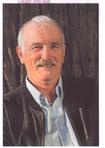John Michael McCarty's Blog, page 11
July 31, 2017
Communes of west Sonoma County
Music was always in the air with hippies breaking into song without provocation or reason. A rhythm section would soon appear, kids of all ages banging on inverted cans or upturned oatmeal boxes. Celebrated musicians would also lend their melodic muses to the festivities. The Steve Miller Band, The Grateful Dead, The Limeliters (of which Lou Gottlieb was an original member), Moby Grape, Jimi Hendrix and others would show up announced.
Communes of the Sixties:
These communes of the sixties beckoned seers and scholars, builders and gardeners, soldiers and survivors, hippies and trolls, and a cowboy or two. No one was turned away and everyone coexisted on the barter system. Skill sets were freely offered in an anarchist atmosphere with no hierarchy.
Nirvana would soon be invaded by outside forces. Morningstar and Wheeler ranches eventually succumbed to the threats of a conservative establishment. Court cases evolved around issues such as increased traffic, noise pollution, easement transgressions, health code violations, illegal drug use and teen runaways. Both Bill and Lou tried to evade the long arm of the law by willing their lands to God. After all, who ever heard of God committing violations against mankind, or against any other species for that matter. As a bonus, God would not be required to pay property taxes. The 9th Circuit Court, however, stated that “God had no property rights in California”. The bulldozers came in 1973 and so ended the great experiment in “freedom”.
The post Communes of west Sonoma County appeared first on John McCarty.
May 29, 2017
Fleishhacker Zoo in San Francisco
 Fleishhacker Zoo in San Francisco was named after its founder, Herbert Fleishhacker, who was a banker and Park Commission president. Construction began in 1929 on the site adjacent to the largest outdoor pool in the world (Fleishhacker Pool) and soon thereafter the first tiger cubs had their paws and noses fingerprinted. Thousands remember riding the Fleishhacker Playfield Limited affectionately known as “Little Puffer”. You’d never guess that this fully functional steam train is pushing one hundred years. Little Puffer is one of only three 22-inch gauge engines remaining in the world today.
Fleishhacker Zoo in San Francisco was named after its founder, Herbert Fleishhacker, who was a banker and Park Commission president. Construction began in 1929 on the site adjacent to the largest outdoor pool in the world (Fleishhacker Pool) and soon thereafter the first tiger cubs had their paws and noses fingerprinted. Thousands remember riding the Fleishhacker Playfield Limited affectionately known as “Little Puffer”. You’d never guess that this fully functional steam train is pushing one hundred years. Little Puffer is one of only three 22-inch gauge engines remaining in the world today.
The zoo is the birthplace of Koko the gorilla who can be seen in the photo cradling a kitten. Visitors remember what a ham Koko was, often times seen holding binoculars and gawking back at them or drinking a cup of coffee or lifting the T-shirt of a trainer and tickling him.
Fleishhacker Zoo:
At the Fleishhacker Zoo in 2006, Tatiana, a 242-pound Siberian tiger, attacked a trainer, sending the person to the hospital and causing the Lion House to be closed for ten months. A year later this same tiger escaped from her grotto and attacked three visitors who were taunting the animal. One of the taunters was killed and another was tracked and mauled but survived. Unfortunately, Tatiana was killed at the scene by police.
On a lighter note, 2006 was the same year that Fleishhacker Zoo named a bald eagle after comedian Stephen Colbert. Do you remember Uulu? At 36, she was the oldest polar bear in captivity in the U.S. at the time.
From more on the activities along the Great Highway in old San Francisco, go to www.johnmccarty.org and click on “Ocean Beach” at the bottom of any page. Enjoy!
The post Fleishhacker Zoo in San Francisco appeared first on John McCarty.
March 29, 2017
One Percenters High and Low
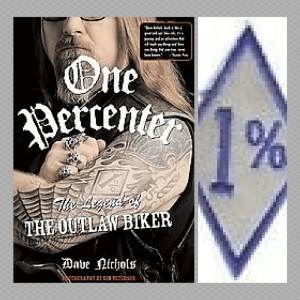 Some one percenters you have fun messing with such as anyone on the front cover of Fortune magazine. Others not so much. There’s an undeniable camaraderie among us common folk to throw the top 1% wealthiest under the bus. However, it’s a different matter altogether when you run across a biker with the same moniker.
Some one percenters you have fun messing with such as anyone on the front cover of Fortune magazine. Others not so much. There’s an undeniable camaraderie among us common folk to throw the top 1% wealthiest under the bus. However, it’s a different matter altogether when you run across a biker with the same moniker.
Members of outlaw motorcycle clubs such as the Hells Angels, Pagans, Warlocks and Bandidos wear the diamond-shaped patch over their leather jackets. The inspiration for this was traced to 1947 when members of “The Pissed Off Bastards” and the “Boozefighters” motorcycle clubs showed up in Hollister, CA for a bike race which went sideways. The Life magazine story that followed provoked the American Motorcyclist Association (AMA) to denounce the boozed-up bikers. It assured the average Joe that 99% of bikers were law-abiding citizens.
Outlaws as One Percenters:
Bad boys everywhere latched onto the decry from the article, saying they were proud to be the 1% cast as outlaws. The most feared and respected riders roaming the blacktop, one percenters are a breed apart from all others. These individuals bow to no one, test the boundaries of all and give their devotion to few. Without wanting to glorify them, as a writer I find their persona still haunting after all these years. Hopefully, in Don’t Stop the Music, Sonny Barger (founder of Hells Angels-Oakland Chapter) will not be exalted, but neither will he be thrown under the bus.
The post One Percenters High and Low appeared first on John McCarty.
March 2, 2017
Downtown Monte Rio, California
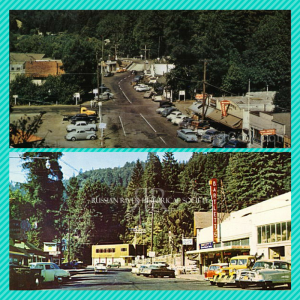 Downtown Monte Rio, California, in rural west Sonoma County was a bustling community at one time. During the Big Band era, the downtown boasted at least three hotels, several saloons, restaurants, dance hall, railroad station, etc. The North Pacific Coast R.R. delivered as many as fifteen thousand visitors on a summer weekend with holidays such as the 4th of July seeing that number doubled.
Downtown Monte Rio, California, in rural west Sonoma County was a bustling community at one time. During the Big Band era, the downtown boasted at least three hotels, several saloons, restaurants, dance hall, railroad station, etc. The North Pacific Coast R.R. delivered as many as fifteen thousand visitors on a summer weekend with holidays such as the 4th of July seeing that number doubled.
After the last train pulled out in 1935, you witnessed a decrease in tourists, but you still had plenty of activity. The photos show Main Street during the early 1950’s. On the south side (top pic), you had various businesses including the Pink Elephant bar, Heinlein’s Cafe, entrance to amphitheater, Knotty Room diner, Noonan’s Market, and Lee Torr Jr.’s Real Estate and Insurance (now Burger’s Construction Shop).
Downtown Monte Rio:
On the north side of Main Street (bottom pic) in downtown Monte Rio, Bartlett’s grocery store was and still is the primary store for the locals. At the intersection of Moscow Rd. and Main Street was Stella’s Bakery. Further north of the bakery on Moscow was the old Post Office (now the Russian River Historical Society). To the east of Bartlett’s was Lara’s Garage (now Noel’s Automotive Service) and Chevron gas station. Next door and near Dutch Bill Creek was Yee’s Chinese restaurant. We shouldn’t forget across the bridge where a rollerskating rink/cafe once stood adjacent to the existing Rio Theater. Next door was Ramona’s hamburger stand while Kohler’s Hardware was across the street (now Napa Auto Parts). Remember the Union 76 Gas Station in front of Fern’s?
I’m seeking stories, descriptions, etc. of the above places. If you have a memory of downtown Monte Rio during the 1950’s and/or 1960’s, I would very much like to hear it. You can reach me at john@johnmccarty.org. With your permission, your name and story will appear in my March online newsletter. Thank you.
The post Downtown Monte Rio, California appeared first on John McCarty.
February 20, 2017
Negri’s Restaurant in Occidental
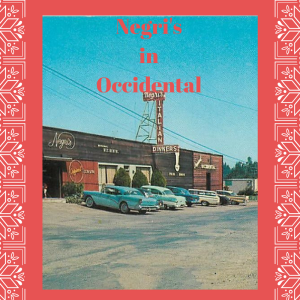 Negri’s Restaurant in Occidental came to be when Joe Negri Sr. crossed the Atlantic and left the canals of Venice behind. After landing on Ellis Island, he soon found a job cooking at the Waldorf Astoria Hotel in N.Y. where he caught the attention of Rudolph Valentino. Joe soon became Valentino’s personal chef, traveling to San Francisco. Mr. Negri later moved north to Occidental in 1938 and purchased the site where Negri’s rests today.
Negri’s Restaurant in Occidental came to be when Joe Negri Sr. crossed the Atlantic and left the canals of Venice behind. After landing on Ellis Island, he soon found a job cooking at the Waldorf Astoria Hotel in N.Y. where he caught the attention of Rudolph Valentino. Joe soon became Valentino’s personal chef, traveling to San Francisco. Mr. Negri later moved north to Occidental in 1938 and purchased the site where Negri’s rests today.
His wife Theresa cooked while Joe ran the bar. He always had a quarter and a joke ready for the children as he traveled through the dining room to greet customers. Joe passed in 1970 and Theresa left us in 1994. Today Evelyn Negri, her daughter Sandy, and her grandchildren Amanda and Tori take care of the family legacy.
Negri’s Restaurant:
In the bar at Negri’s Restaurant, you might catch Nick Gravenites (Electric Flag & Big Brother and the Holding Company) strumming his blues guitar. The background music sets the tone for the family-style dinners, which are still served on red-and-white tablecloths, decorated with old Chianti bottles dripping with wax. The meal includes minestrone, ravioli, antipasto, salami and olives, salad and French bread along with your entree. The raviolis slide off your taste buds, not chewy like the traditional al dente style at the Union Hotel across the street. They are a blend of beef, pork, Swiss chard and herbs and are my personal favorite. But let’s be honest. All of the above is just an excuse to try one of their fritters. These treats consist either of two whole apple rings or a fresh banana, which are dipped in a homemade sweet batter, deep fried to a golden brown and dusted with powdered sugar. Let the heart attack begin!
The post Negri’s Restaurant in Occidental appeared first on John McCarty.
February 18, 2017
Fiori’s Restaurant in Occidental
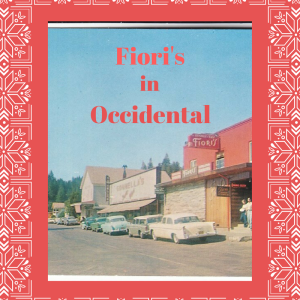 Fiori’s Restaurant in Occidental was the pride and joy of Ray Fiori, a tireless chef who oversaw some of the county’s most popular kitchens in the 1960s, ’70s and ’80s. Born Aug. 29, 1924, in Santa Rosa to Clara and Anthony Fiori, Ray was one of four children reared in the restaurant world. He attended grammar school in Santa Rosa before the family moved to Occidental to open Fiori’s restaurant in 1935.
Fiori’s Restaurant in Occidental was the pride and joy of Ray Fiori, a tireless chef who oversaw some of the county’s most popular kitchens in the 1960s, ’70s and ’80s. Born Aug. 29, 1924, in Santa Rosa to Clara and Anthony Fiori, Ray was one of four children reared in the restaurant world. He attended grammar school in Santa Rosa before the family moved to Occidental to open Fiori’s restaurant in 1935.
Ray Fiori eventually enrolled at Tomales High School. After graduation, he joined the Army Air Forces, but his plane crashed during a training mission and the bellygunner suffered injuries that cut short his stint in the service. After being medically discharged, he returned to Sonoma County and his parents’ Occidental restaurant.
Fiori’s Restaurant”
A favorite spot for the kids at Fiori’s Restaurant was at the pinball machines in the bar area. “It was a family business,” said Fiori’s daughter, Tamela Mesenbrink of Sebastopol. “I guess Ray knew it was his calling.” In addition to the minestrone soup, salad and entree, the Italian dinner included zucchini pancakes, a platter of lamb stew and banana fritters. By the time you reached the dessert, you realized that what made the meal exceptional was not just the ingredients, but the flavor of being welcomed into a home with a warm embrace and a place at the family table for everyone. The extended family ran and staffed the restaurant until it was sold in 1969. Ray Fiori passed away at age 88 in 2012.
What do you remember of Fiori’s?
The post Fiori’s Restaurant in Occidental appeared first on John McCarty.
February 5, 2017
Gold Spike Restaurant in San Francisco
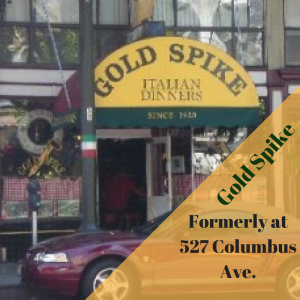 The Gold Spike restaurant in San Francisco was another Italian family-style dinner-house in North Beach that was forced to close. The place was part of a large building that wrapped around the block and encompassed many storefronts, including O’Reilly’s Irish Bar & Restaurant and L’Osteria del Forno.
The Gold Spike restaurant in San Francisco was another Italian family-style dinner-house in North Beach that was forced to close. The place was part of a large building that wrapped around the block and encompassed many storefronts, including O’Reilly’s Irish Bar & Restaurant and L’Osteria del Forno.
Attilio and Natalina Mechetti, immigrants from Italy’s Tuscany region, opened the joint in 1920 as the Columbus Candy Store and Soda Fountain, although soda was not the only drink served. Prohibition was on, and the Mechettis knew how to treat their customers well.
The Gold Spike featured an uneven floor in the front dining area near the bar as well as business cards and dollar bills plastered all over the walls and ceiling. Even the stuffed moose and marlin were tagged.
Gold Spike:
Remember the rusty horseshoes and the glossy football posters? Besides the comfy decor, the Gold Spike served huge portions with the butteriest, garlicky bread this side of Rome. Doggie-bags were routine. The menu stayed the same over the years. The five-course meal at Gold Spike included soup, salad, pasta, entree and dessert, which went for $24.95–a rather steep price back at the turn of the century. While the food wasn’t the best, you truly felt as if you were part of a family when you arrived. Many celebrations took place there: first dates, birthdays, anniversaries, memorials, graduations, etc.
Paul Machetti, the last of four generations of family owners, had to shut the restaurant’s doors in February of 2006 after 86 years in the same location. Evidently, he couldn’t afford the sewage and earthquake upgrades that his landlord demanded.
The post Gold Spike Restaurant in San Francisco appeared first on John McCarty.
January 27, 2017
Capp’s Corner and Caesar’s in San Francisco
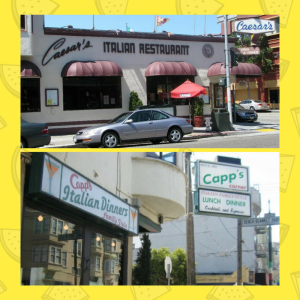 Two of my favorite restaurants that are no longer with us are Capp’s Corner and Caesar’s in San Francisco. Capp’s was established in 1963 and closed in 2015. Formerly at 1600 Powell Street, it sat next to Beach Blanket Babylon. The Italian restaurant was a favorite of not only tourists but cops, barmen, retirees and locals.
Two of my favorite restaurants that are no longer with us are Capp’s Corner and Caesar’s in San Francisco. Capp’s was established in 1963 and closed in 2015. Formerly at 1600 Powell Street, it sat next to Beach Blanket Babylon. The Italian restaurant was a favorite of not only tourists but cops, barmen, retirees and locals.
No one could greet you better than Seamus Coyle with his Irish way. The dinners were healthy portions with reasonable prices. Remember the tasty tureen of homemade minestrone followed by the kidney bean house salad? Nice way to start a meal. Apparently the long-time Ginella owners were one of the latest victims of the City’s eviction frenzy. Even the praises of Governor Jerry Brown and poet Lawrence Ferlinghetti couldn’t sway the landlord. Sad!
Caesar’s Restaurant:
Caesar’s restaurant closed in 2012 after 56 years in operation. The Italian eatery in North Beach was formerly at 2299 Powell Street at Bay. That was the place for a special celebration whether it be a birthday, anniversary or the opening of mushroom season. Didn’t matter. It had the IT factor with waiters in tuxedos. Could you finish the seven-course dinner? Did you ever try their pig’s feet as an appetizer? “Eat where the Italians eat” was their motto. The only thing better than the Cioppino was the smiling face of the late Luigi Romani.
The post Capp’s Corner and Caesar’s in San Francisco appeared first on John McCarty.
January 20, 2017
San Francisco Restaurants of Yesteryear
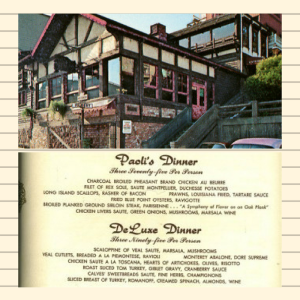 Here are a couple of San Francisco restaurants of yesteryear that I wish were still with us. The Shadows on Telegraph Hill was formerly located at 1349 Montgomery Street. Maybe you couldn’t afford to take your sweetheart to Julius Castle down the street, but at the Shadows a sawbuck would land you a classy dish from their extensive German-Swiss-Continental menu. My date selected hasenpfeffer, a stew made from marinated rabbit. Another patron approached and complained about her eating the “nice, fussy” animal. The chef stormed out of the kitchen and lectured the person on the history of his favorite cuisine. After dinner, we relaxed by the bar in the Swiss chalet room, drinking our sweet-and-sour cocktails while gazing out the picture window to the Bay Bridge and beyond. A romantic adventure led us across the street to the nearby Filbert Steps where I stole a kiss from my date to the background music of wild parrots.
Here are a couple of San Francisco restaurants of yesteryear that I wish were still with us. The Shadows on Telegraph Hill was formerly located at 1349 Montgomery Street. Maybe you couldn’t afford to take your sweetheart to Julius Castle down the street, but at the Shadows a sawbuck would land you a classy dish from their extensive German-Swiss-Continental menu. My date selected hasenpfeffer, a stew made from marinated rabbit. Another patron approached and complained about her eating the “nice, fussy” animal. The chef stormed out of the kitchen and lectured the person on the history of his favorite cuisine. After dinner, we relaxed by the bar in the Swiss chalet room, drinking our sweet-and-sour cocktails while gazing out the picture window to the Bay Bridge and beyond. A romantic adventure led us across the street to the nearby Filbert Steps where I stole a kiss from my date to the background music of wild parrots.
Paoli’s Restaurant:
Paoli’s restaurant was located at 575 Commercial Street near Montgomery in the Financial District of San Francisco. As a young teacher, I had to stretch every dollar. Paoli’s happy-hour buffet was the best bargain in town for both scenery and tasty appetizers. Practically the entire dinner menu could be sampled at the buffet table near the bar. And if you were lucky enough, perhaps you would further satisfy your appetite with a young lady’s conversation, fresh off her job from the Pacific Stock Exchange or Macy’s or the Emporium-Capwell and looking good!
The post San Francisco Restaurants of Yesteryear appeared first on John McCarty.
January 12, 2017
Benny Barth, musician and local treasure
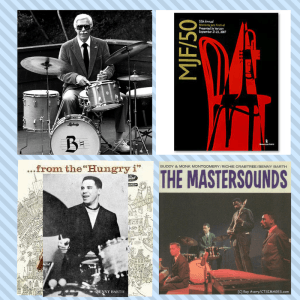 Benny Barth, musician and local treasure, was born in Indianapolis, Indiana in 1929, becoming a song-and-dance man by the age of four. He took up the trumpet but soon left it behind when he noticed that the girls liked him better as a drummer. Benny received a music scholarship to Butler University where he played the best black jazz clubs in the city. To this day, he is the only white member of the Bebop Society of Indianapolis. When the group met at Benny’s house, they would gather in a circle with their arms around each other, each scatting two choruses of Dizzy Gillespie’s “Hooly Koo”. In this segregated city, neighbors would prance by, shielding children from the sinful sight.
Benny Barth, musician and local treasure, was born in Indianapolis, Indiana in 1929, becoming a song-and-dance man by the age of four. He took up the trumpet but soon left it behind when he noticed that the girls liked him better as a drummer. Benny received a music scholarship to Butler University where he played the best black jazz clubs in the city. To this day, he is the only white member of the Bebop Society of Indianapolis. When the group met at Benny’s house, they would gather in a circle with their arms around each other, each scatting two choruses of Dizzy Gillespie’s “Hooly Koo”. In this segregated city, neighbors would prance by, shielding children from the sinful sight.
He became part of the Mastersounds that were signed by World Pacific Records in the late fifties. They were hot, playing at the Blue Note in Chicago as well as the original Birdland in New York. These boys had hit the national scene.
Benny Barth:
Benny Barth and the Mastersounds played at the first Monterey Jazz Festival in 1958 (and later at its 50th anniversary) and the Newport Jazz Festival the following year. If you ask Benny for his favorite recording, he might just say “Stranger in Paradise”. After the band disbanded, Benny played in San Francisco when it was known as the Harlem of the West. He played at The Tropics on Geary, Basin Street West, Jazz Cellar in North Beach, and the Coffee Gallery. Many music enthusiasts remember Benny as the house drummer at the Hungry i. For several years there, he backed up Mel Torme, Barbra Streisand and John Hendricks.
Other artists that Benny has played with are: Duke Ellington, Dizzie Gillespie, Vince Guaraldi, and Peggy Lee to name just a few. Benny also worked with Wes Montgomery, the greatest jazz guitarist who ever lived and a major influence on Benny’s career.
Benny made his initial trip to the redwoods in 1977 when he strutted his skills at the first Russian River Jazz Festival. A few years later he met his soulmate, Diane Cosgrove. They soon married in a swinging ceremony under the trees that featured the seventeen-piece Rudy Salvini Big Band (over two hundred musicians stepped in for a song or two). Thank you, Benny, for sharing your talent with us. Cheers!
The post Benny Barth, musician and local treasure appeared first on John McCarty.

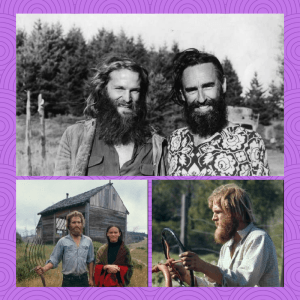 Bill Wheeler and Lou Gottlieb established communes in west Sonoma County in 1967 during the Summer of Love fifty years ago. Lou’s Morning Star Ranch was west of Sebastopol while Wheeler Ranch was on Coleman Valley Road west of Occidental. The land set people free of convention, government and uptight parents. Abodes consisted of everything from earthen domes to tree houses to a mattress under the stars. There was no electricity while showers were found under a garden hose or inside a sweat house. The preferred dress code was au naturel, weather permitting.
Bill Wheeler and Lou Gottlieb established communes in west Sonoma County in 1967 during the Summer of Love fifty years ago. Lou’s Morning Star Ranch was west of Sebastopol while Wheeler Ranch was on Coleman Valley Road west of Occidental. The land set people free of convention, government and uptight parents. Abodes consisted of everything from earthen domes to tree houses to a mattress under the stars. There was no electricity while showers were found under a garden hose or inside a sweat house. The preferred dress code was au naturel, weather permitting. 